![]()
![]()
![]()
Use LEFT and RIGHT arrow keys to navigate between flashcards;
Use UP and DOWN arrow keys to flip the card;
H to show hint;
A reads text to speech;
482 Cards in this Set
- Front
- Back
|
One thing that E. Coli and other bacteria have in common with eukaryotes is the presence of _________.
|
Ribosomes
|
|
|
Prokaryotes are __________.
|
Unicellular
|
|
|
Some have ________ forms.
|
Colonial
|
|
|
Prokaryotes range in size from ________ um.
|
1-5
|
|
|
Prokaryotes have ___________ organelles.
|
no membrane-bound
|
|
|
Prokaryotes have ____________ chromosomes.
|
Circular
|
|
|
Maintains cell shape, provides physical protection, prevents cell from bursting in a hypotonic environment.
|
Cell wall
|
|
|
Prokaryotic cell walls are composed of ____________. May also have an outer _____________ membrane.
|
Peptidoglycan; Phospholipid
|
|
|
May cover the cell wall of many prokaryotes.
|
Capsule
|
|
|
A sticky layer of polysaccharide or protein.
|
Capsule
|
|
|
__________ and _________ allow prokaryotes to stick to their substrate or other individuals in a colony.
|
Fimbriae; pilli
|
|
|
Move by means of a flagella.
|
Motile bacteria
|
|
|
Motile bacteria is structurally different from _____________ flagella.
|
Eukaryptic
|
|
|
In a heterogeneous environment, bacteria exhibit _________.
|
Taxis
|
|
|
An ability to move toward or away from certain simuli.
|
Taxis
|
|
|
Positive ________ is the ability to move toward a chemical stimulus.
|
Chemotaxis
|
|
|
Prokaryotes _________ have membrane-bound organelles.
|
Do not
|
|
|
Some prokaryotes have ________ membranes that perform metabolic functions.
|
Specialized
|
|
|
Prokaryotic chromosome are _______ DNA found in the nucleoid region; not within the _________.
|
Circular; nucleus
|
|
|
Small circular DNA rings.
|
Plasmids
|
|
|
Prokaryotes reproduce quickly by this.
|
Binary fission
|
|
|
Prokaryotes divide every ______ hours.
|
1-3
|
|
|
Prokaryotes are a form of ________ reproduction, which produces genetically identical daughter cells.
|
Asexual
|
|
|
Transfer of genetic material between two bacteria.
|
Bacterial conjugation
|
|
|
Bacterial conjugation not necessarily between the same species.
|
Horizontal gene transfer
|
|
|
These are usually transferred from donor through a sex pilus.
|
Plasmids
|
|
|
Groups of staphylococci (cocci) look ________.
|
Spherical
|
|
|
Cell-surface structures
|

Cell-surface structures
|
|
|
Prokaryotic cells have a variety of shapes.
|
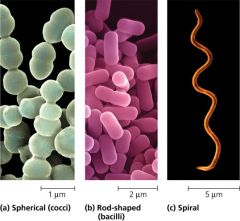
Most common:
Spheres (-cocci) Rods (-bacilli) Spirals (-spirilli) |
|
|
Bacterial capsule
|
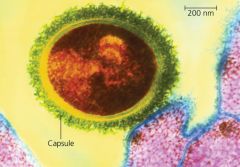
Bacterial capsule
|
|
|
Prokaryotic fimbriae
|
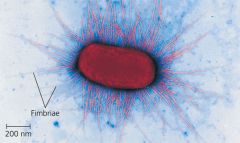
Prokaryotic fimbriae
|
|
|
Motile bacteria
|
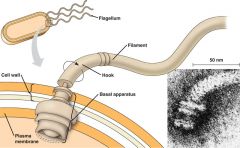
Motile bacteria
|
|
|
Internal organization
|

Internal organization
|
|
|
Concept 27.2:
|
A great diversity of nutritional and metabolic adaptations have evolved in prokaryotes.
|
|
|
Organism that obtain energy from light.
|
Phototrophs
|
|
|
Organisms that obtain energy from chemicals.
|
Chemotrophs
|
|
|
Organisms that need only the inorganic compound CO2 as a carbon source.
|
Autotrophs
|
|
|
Organisms that need at least one organic compound (e.g. Glucose) to make other organic compounds.
|
Heterotrophs
|
|
|
An autotrophic organism might _________?
|
Engage in chemosynthesis
|
|
|
Chemosynthesis __________?
|
Enables the synthesis of organic molecules using energy from inorganic molecules
|
|
|
Prokaryotic _________ can vary with respect to oxygen availability.
|
Metabolism
|
|
|
Require oxygen.
|
Obligate aerobes
|
|
|
Can survive with or without oxygen.
|
Facultative anaerobes
|
|
|
Are poisoned by oxygen.
|
Obligate anaerobes
|
|
|
In __________ respiration, substance other than oxygen, act as electron acceptors (eg, NO3-, SO4 2-).
|
Anaerobic
|
|
|
Some prokaryotes can metabolize ________.
|
Nitrogen
|
|
|
In _____________, bacteria convert N2 (nitrogen gas) to NH3 (ammonia).
|
Nitrogen fixation
|
|
|
Cooperation between prokaryotes, allows them to use resources they could not us individually.
|
Metabolic cooperation
|
|
|
The cyanobacterium Anabaena:
|
Photosynthetic cells, nitrogen-fixing cells: Heterocytes.
|
|
|
Which types of bacteria can live in the presence of oxygen?
|
Only obligate aerobes and facultative fermentation.
|
|
|
Major nutritional modes of prokaryotes.
|

Major nutritional modes of prokaryotes.
|
|
|
Cyanobacterium: Anabaena
|
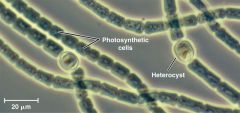
Cyanobacterium: Anabaena
|
|
|
Concept 27.3:
|
Molecular systematic is illuminating prokaryotic phylogeny
|
|
|
Based prokaryotic taxonomy on phenotypic criteria.
|
Systematists
|
|
|
Applying molecular systematics to the investigation of prokaryotic phylogeny:
|
1. Has led to a phylogenetic classification of prokaryotes.
2. Allows systematists to identify major new clades. |
|
|
Domain Bacteria:
|
-Proteobacteria
-Chlamydias -Spirochetes -Gram-positive bacteria -Cyanobacteria |
|
|
________ share traits with both bacteria and eukaryote.
|
Archaea
|
|
|
Archaeans are often found in _______ environments.
|
Extreme
|
|
|
Thrive in very hot environments.
|
Thermophiles
|
|
|
Thrive under high pressure.
|
Barophiles
|
|
|
Live in anoxic environments (eg, swamps and marshes), produce methane as a waste product.
|
Mathanogens
|
|
|
Live in high saline environments.
|
Halophiles
|
|
|
Which type of bacteria would you most likely find in very salty water?
|
Extreme halophiles
|
|
|
A tenative phylogeny
|
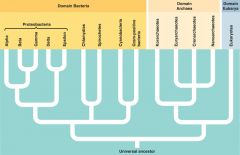
A tenative phylogeny
|
|
|
Domain Bacteria
|
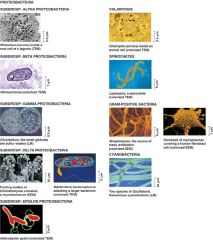
Domain Bacteria
|
|
|
Concept 27.4:
|
Prokaryotes play crucial roles in the biosphere.
|
|
|
Chemical recycling: _______ play a major role in recycling chemical elements between the living and nonliving environment.
|
Prokaryotes
|
|
|
Are decomposers.
|
Chemoheterotrophs
|
|
|
Chemoheterotrophs:
|
break down corposes, dead vegetation, and waste products.
|
|
|
___________ prokaryotes add usable nitrogen to the environment.
|
Nitrogen-fixing
|
|
|
Many prokaryotes live in ___________ or _________ relationships with other organisms.
|
Multicellular; commensalistic
|
|
|
Symbiotic relationships
|
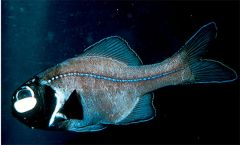
Symbiotic relationships
|
|
|
Which best describes most membranes of the kingdom Protista?
|
They are single-celled and eukaryotic.
|
|
|
_______ are more diverse than all other eukaryotes.
|
Protists
|
|
|
Protists are mostly ________, but some have colonial and multicellular forms.
|
Unicellular
|
|
|
Protists reproduce _________.
|
Asexually and sexually
|
|
|
Contain chloroplast, photosynthesize.
|
Photoautotrophs - protists
|
|
|
Absorb organic molecules or ingest larger particlees.
|
Heterotrophs - protists
|
|
|
Combine photosynthesis and heterotrophic nutrition.
|
Mixotrophs - protists
|
|
|
Endosymbosis in Eukaryotic Evolution
|
-Much protist diversity has its origin in endosymbiosis.
-Plastid-bearing lineage evolved into red and green algae. -Both underwent secondary endosymbiosis. |
|
|
Which would be a key identifying characteristic of an organelle that has undergone secondary endosymbiosis?
|
Four plasma membranes
|
|
|
Protists are an extremely diverse assortment of eukaryotes. Reproduces sexually and sexually.
|
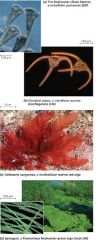
Protists are an extremely diverse assortment of eukaryotes.
|
|
|
Endosymbiosis in Eukaryotic Evolution
|
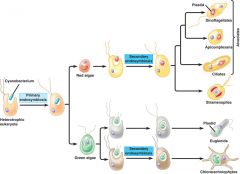
Endosymbiosis in Eukaryotic Evolution
|
|
|
A Tentative Phylogeny of Eukaryotes.
|

A Tentative Phylogeny of Eukaryotes.
|
|
|
Are adapted to anaerobic environments, lack plastids, and have mitochondria that lack DNA, an electron transport chain, or citric acid cycle enzymes.
|
Diplamonads and parabosalids
|
|
|
Have 2 nuclei and multiple flagella.
|
Diplomonads (eg, Giardia interestinalis)
|
|
|
Move by means of a flagella and an undulating membrane.
|
Parabasalids (eg, Trichemnoas vaginalis)
|
|
|
Diplomonads and Parabasalids
|
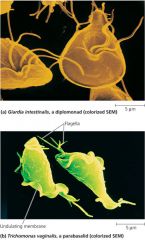
Diplomonads and Parabasalids
|
|
|
Concept 28.3:
|
Euglenozoans have flagella with a unique, internal structure.
|
|
|
Includes heterotrophs, photosynthetic autotrophs, and parasites.
|
Euglenozoa
|
|
|
Single, large mitochondrion containing an organized mass of DNA.
|
Kinetoplast
|
|
|
Includes free-living consumers in freshwater, marine, and moist terrestrial habitats.
|
Kinetoplastids
|
|
|
Have one or two flagella that emerge from a pocket at one end of the cell.
|
Euglenids
|
|
|
Euglenids stores the glucose polymer _________.
|
Paramylan
|
|
|
________ are diverse groups of aquatic photoautorophs and heterotrophs.
|
Dinoflagellates
|
|
|
Abundant components of marine and freshwater.
|
Phytoplankton
|
|
|
Rapid growth of some __________ is responsible for "red tides" which can be toxic to humans.
|
Dinoflagellates
|
|
|
Some dinoflagellates are ___________.
|
Bioluminescent
|
|
|
Parasites of animals, some causes diseases (plasmodium causes malaria).
|
Apicomplexans
|
|
|
Apex of apicomplexans contains a complex of organelles for _________ host cells and tissues.
|
Penetrating
|
|
|
Named for their use of cilia to move and feed.
|
Ciliates
|
|
|
Ciliates have ___ nuclei.
|
2
|
|
|
The two nuclei of ciliates are:
|
Macronucleus: controls everyday functions.
Micronucleus: used in conjugation |
|
|
The ________ nuclei function during conjugation.
|
Micro
|
|
|
A sexual process that produces genetic variation and is separate from reproduction, which generally occurs by binary fission.
|
Conjugation
|
|
|
Sexual reproduction in ciliates involves __________?
|
The exchange of haploid micronuclei between two individuals.
|
|
|
Dinoflagellates, apicomplexans, and ciliates are place in the ALveolata because they all:
|
Have membrane-bound sacs under their plasma membranes.
|
|
|
Main feature is a spiral or crystalline rod of unknown function inside their flagella.
|
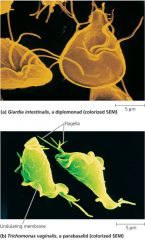
Main feature is a spiral or crystalline rod of unknown function inside their flagella.
|
|
|
Parasite Trypanosome - causes African sleeping sickness.
|
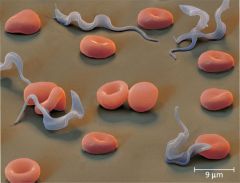
Parasite Trypanosome - causes African sleeping sickness.
|
|
|
Euglenids: some are mixotrophic.
|
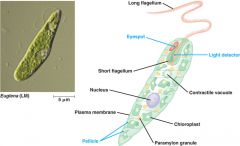
Euglenids: some are mixotrophic.
|
|
|
Alveolates have sacs beneath the plasma membrane.
|
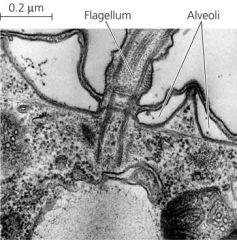
Alveolates have sacs beneath the plasma membrane.
|
|
|
Dinoflagellates: Two flagella make hem spin as they move through the water.
|
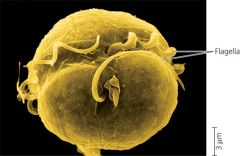
Dinoflagellates: Two flagella make hem spin as they move through the water.
|
|
|
Apicoplast-nonphotosynthetic plastid.
|
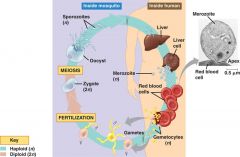
Apicoplast-nonphotosynthetic plastid.
|
|
|
Ciliates
|
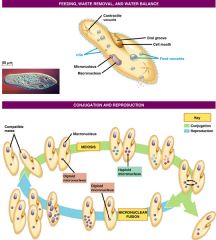
Ciliates
|
|
|
Concept 28.5:
|
Stramenophiles have "hairy" and smooth flagella
|
|
|
Previously considered fungi, based on morphology.
|
Oomycetes
|
|
|
Filaments that faciliate nutrient uptake.
|
Hyphae (oomycetes)
|
|
|
Cause late blight of potatoes (brought about the Irish potato famine).
|
Phytophthora infestans (oomycetes)
|
|
|
________ are unicellular algae (photoautotrophs).
|
Diatoms
|
|
|
Diatoms are major components of _______.
|
Phytoplankton
|
|
|
Diatomaceous earth
|
Accumulated diatom tests in marine sediments; used in toothpastes and filter media.
|
|
|
Golden Algae are also known as _____________.
|
Chrysophytes
|
|
|
Named for their color which results from their yellow and brown carotinoids.
|
Golden Algae
|
|
|
Brown algae are also known as ___________.
|
Phaeophytes
|
|
|
Largest and most complex algae; all multicellular and mostly marine; seaweeds.
|
Brown algae
|
|
|
A variety of life cycles have evolved among __________ algae.
|
Multicellular
|
|
|
Alteration of generations in life cycle include multicellular ______ and _______.
|
Haploid; diploid
|
|
|
Alternation of generation implies a diploid, spore-producing phase alternating with a(n) ____________________.
|
Haploid gamete producing phase
|
|
|
Stramenophiles: include several groups of heterotrophs as well as certain groups of algae.
|
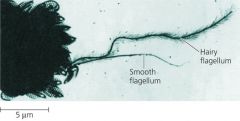
Stramenophiles: include several groups of heterotrophs as well as certain groups of algae.
|
|
|
Water Mold Life Cycle
|
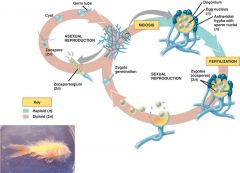
Water Mold Life Cycle
|
|
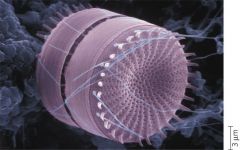
Freshwater Diatom
|

Diatom Diversity
|
|
|
Photoautotrophs with some mixotrophs; mostly unicellular, but some colonial species; Dinobryan.
|
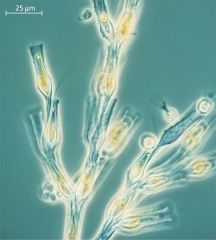
Photoautotrophs with some mixotrophs; mostly unicellular, but some colonial species; Dinobryan.
|
|
|
Photoautotrophs with some mixotrophs; mostly unicellular, but some colonial species; Dinobryan.
|
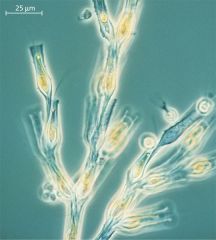
Photoautotrophs with some mixotrophs; mostly unicellular, but some colonial species; Dinobryan.
|
|
|
Brown Algae - seaweeds
|
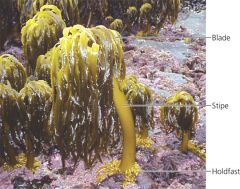
Brown Algae - seaweeds
|
|
|
Alternation of Generations.
|
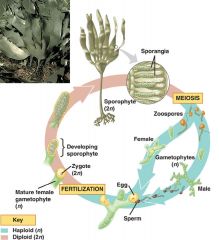
Alternation of Generations.
|
|
|
Concept 28.6:
|
Cercozoans and radiolarians have threadlike psudopodia.
|
|
|
_________ is a newly recognized clade. Many were classified as amoebas in the past.
|
Cercozoa
|
|
|
Are distinguished from the amoebas by their threadlike pseudophodia.
|
Cercozoans and radiolarians
|
|
|
Named for their porous, generally multichambered tests made of calcium carbonate.
|
Foraminiferans
|
|
|
Extend through pores in the test.
|
Pseudopodia
|
|
|
________ form an extensive fossil record.
|
Foram tests
|
|
|
Marine protists with silica tests.
|
Radiolarians
|
|
|
Radiolarians' pseudopodia are known as ________.
|
Axopodia
|
|
|
Radiolarians are used to ________ and ________ microorganisms.
|
Capture; phagocytose
|
|
|
Includes gymnameobas, entamoebas, and slime molds.
|
Amoebozoans: have lobe-shaped pseudopodia
|
|
|
Have lobe-shaped rather than threadlike pseudopodia; common amoebazoans in soil as well as freshwater and marine environments; most are heterotrophic.
|
Gymnameobas.
|
|
|
Parasite of vertebrates and some invertebrates.
|
Entamoebas
|
|
|
Cause amoebic dysentery in humans.
|
Entamoebas histolytica
|
|
|
Slime molds - once thought to be fungi.
|
Mycetozoans
|
|
|
Two main branches of slime molds:
|
Plasmodial slime molds
Cellular slime molds |
|
|
Plasmodial slime molds form a mass called _________.
|
Plasmodium
|
|
|
Plasmodium is:
|
Undivided by membranes and contains many diploid nuclei.
Extends pseudopodia through decomposing matter, engulfing food by phagocytosis. |
|
|
Cellular slime molds form _____________.
|
Multicellular aggregates
|
|
|
Cellular slime molds:
|
Cell separated by their membranes.
|
|
|
Is an experimental model for studying the evolution of multicellularity.
|
Dictyostellium discoideum
|
|
|
Foraminiferans
|
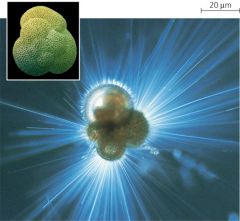
Foraminiferans
|
|
|
Radiolarians
|

Radiolarians
|
|
|
Gymnamoebas
|

Gymnamoebas
|
|
|
Plasmodial Slime Molds Life Cycle
|
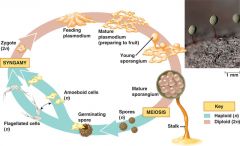
Plasmodial Slime Molds Life Cycle
|
|
|
Cellular Slime Molds
|
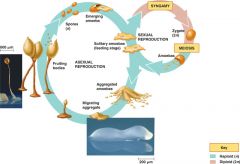
Cellular Slime Molds
|
|
|
Concept 28.8:
|
Red algae and green algae are the closest relatives of land plants
|
|
|
Red algae are reddish in color due to accessory pigment called _________.
|
Phycoerythrinn
|
|
|
Red algae are usually ________.
|
Multicellular and abundant in coastal waters of the tropics.
|
|
|
The red algae, _________, is eaten as crispy sheets or used to wrap sushi.
|
Paraphyra
|
|
|
Named for their green chloroplasts; chlorophyll a and b main pigments.
|
Green algae
|
|
|
Green algae is divided into two main groups:
|
Chlorophytes and Charophytes
|
|
|
________ live in freshwater, also in marine habitats, damp soils, and as symbionts with lichen.
|
Chlorophytes
|
|
|
A single-celled chlorophyte.
|
Chlamydomonas
|
|
|
Biologists believe that ________ gave rise to land plants, because both groups of organisms contain chlorophyll's a and b.
|
Green algae
|
|
|
Chlorophyte life cycle
|
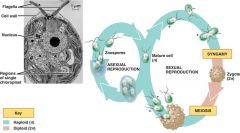
Chlorophyte life cycle
|
|
|
The ancestors of terrestrial plants are considered to be?
|
Charophyceans
|
|
|
Concept 29.1:
|
Land plants evolved from green algae
|
|
|
Have been identified as the closest relatives of land plants.
|
Charophyceans
|
|
|
Four key traits land plants share with charophyceans:
|
1. Rose-shaped complexes for cellulose synthesis.
2. Peroxisome enzymes 3. Structure of flagellated sperm 4. Formation of phragmatoplasts |
|
|
Comparisons of nuclear and chloroplast genes point to close relationship between __________ and ___________.
|
Charophyceans; land plants
|
|
|
Durable ____________ found in charaophycean and lands plants prevents spores from dying out.
|
Polymer sporopollenin
|
|
|
This provides great opportunity for adaptive radiation:
|
1. Sunlight unfiltered by water and plankton
2. Abundance of CO2 3. Nutrient-rich soil 4. Few herbivores and pathogens |
|
|
Systematists are currently debating the boundaries of this kingdom.
|
Plant
|
|
|
Some want to include some or all of the _______ algae.
|
Green
|
|
|
Concept 29.2:
|
Land plant possesses a set of derived terrestrial adaptations
|
|
|
Five key traits appear in nearly all land plants, but are absent in the charophyceans:
|
1. Apical meristem
2. Alternation of generations 3. Walled spores produced in sporgania 4. Multicellular gametangia 5. Multicellular dependent embryos |
|
|
Fossil evidence indicates that plants were on land at least ____________ and have given rise to a vast diversity of plants.
|
475 MYA
|
|
|
Charophyceans have been identified as the closest relatives of land plants.
|
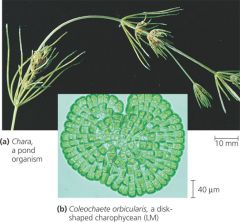
Charophyceans have been identified as the closest relatives of land plants.
|
|
|
Rosette cellulose synthesizing complex
|
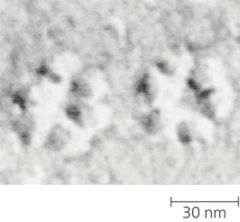
Rosette cellulose synthesizing complex
|
|
|
The origin and diversification of plants
|
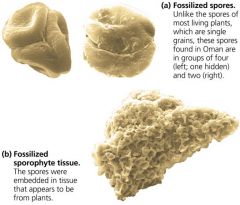
The origin and diversification of plants
|
|
|
Concept 29.3:
|
The life cycles of mosses and other bryophytes are dominated by the gametophyte stage.
|
|
|
Are represented today by three phyla of small herbaceous (nonwoody) plants.
|
Bryophytes
|
|
|
Three phyla of Bryophytes are:
|
1. Liverworts, Phylum Hepatophyta
2. Hornworts, Phylum Anthocerophyta 3. Mosses, Phylum Bryophyta |
|
|
In all three bryophyte phyla, these are the dominant stage of the life cycle.
|
Gametophytes
|
|
|
Bryophyte Gametophytes produce flagellated sperm in _______ and ova in _________. Also form ground hugging carpets and at most are only a few cells thick.
|
Antherida; archegonia
|
|
|
Grow out of archegonia, consists of a foot, a seta, and a sporangium. Hornwort and moss sporophytes have stomata.
|
Bryophyte Sporophytes
|
|
|
Which statement is correct regarding the bryophytes?
|
Archegonia and antheridia are haploid structures and that produce reproductive cells
|
|
|
Bryophyte Diversity: Figures of Hornworts and Liverworts
|
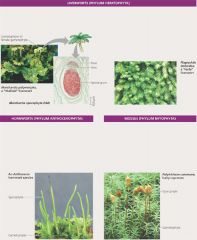
Bryophyte Diversity: Figures of Hornworts and Liverworts
|
|
|
Moss Life Cycle
|
Consult book
|
|
|
Concept 29.4:
|
Ferns and other seedless vascular plants formed the first forests
|
|
|
Origins of Vascular Plants:
|
1. Fossils of the forerunners of vascular plants date back to about 420 MYA.
2. Had independent branching of sporophytes. 3. Lacked other derived traits of vascular plants. |
|
|
Sporophytes of seedless vascular plants are the ________ generation.
|
Larger
|
|
|
The ________ are tiny plants that grow on or below the soil surface.
|
Gametophytes
|
|
|
Classification of Seedless Vascular Plants: Two phyla:
|
Lycophyta: club mosses, spike mosses, and quillworts
Pterophyta: ferns, horsetails, and whisk ferns |
|
|
Vascular plants have 2 types of vascular tissue:
|
Xylem: conducts most of the water and mineral
Phloem: distributes sugars, amino acids, and other organic products |
|
|
Roots of vascular plants serves to:
|
1. Anchor vascular plants
2. Absorb water and nutrients from the soil |
|
|
Leaves of vascular plants serves to:
|
Increase surface area for capturing more sunlight
|
|
|
Ancestors of modern ______, _______, and _____ formed the first forests during the ______ period.
|
lycophytes, horsetails, and ferns during the Carbiniferous period.
|
|
|
Which is a land plant that produces flagellated sperm and has a sporophyte-dominated life cycle?
|
Pterophyta
|
|
|
The bryophytes have independent ________ as well as attached dependent __________.
|
Gametophytes, sporophytes
|
|
|
Coal consists primarily of compressed remains of the _____ that dominated Carboniferous swamp forests.
|
Seedless vascular plants
|
|
|
Origins of Vascular plants
|
Consult book
|
|
|
Fern Life Cycle
|
Consult book.
|
|
|
Concept 30.1:
|
The reduced gametophytes of seed plants are protected in ovules and pollen grains.
|
|
|
Characteristics common to all seed plants:
|
1. Seeds
2. Reduced gametophytes 3. Heterospory 4. Ovules 5. Pollen |
|
|
Develop within the walls of spores retained within tissues of the parent sporophyte and is no longer dependent on water for fertilization.
|
Gametophytes of seed plants
|
|
|
Heterospory: The rule among seed plants. Seed plants evolved from plants that had _______ , the female symbol gametophytes and _______, the male symbol.
|
Megasporangia; Micrsporangia
|
|
|
Consists of a megasporangium, megaspore, and protective integuments.
|
Ovule
|
|
|
Develop into pollen grains and contains male gametophytes.
|
Microspores
|
|
|
Can be dispersed by air or animals, eliminates the water requirement for fertilization.
|
Pollen
|
|
|
If a pollen grain ________, it gives rise to a pollen tube that discharges two sperm into the female gametophyte within the ovule.
|
Germinates
|
|
|
Develops from the whole ovule, includes sporophyte embryo, food supply, protective coat.
|
A seed
|
|
|
Which does not apply to gymnosperms or angiosperms?
-Vascular tissues -Diploid dominance -Single spore type -Cuticle with stomata |
Single spore type
|
|
|
Gametophyte/Sporophyte relationships
|
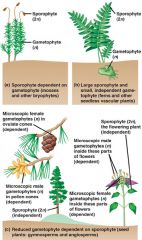
Gametophyte/Sporophyte relationships
|
|
|
Ovules and production of Eggs
|

Ovules and production of Eggs
|
|
|
Concept 30.2:
|
Gymosperms bear "naked seeds" typically on cones
|
|
|
Fossils reveal that the late Devorian plants called ________ had some characteristics of seed plants.
|
Progymnosperms
|
|
|
Gymnosperms dominated ________ terrestrial ecosystems and were also known as the "Age of Cycads".
|
Mesozoic
|
|
|
Key features of the gymnosperm life cycle include:
|
1. Dominance of the sporophyte generation
2. The role of pollen in transferring sperm to ovules (no water is required) 3. The development of seed form fertilized ovules. |
|
|
How many generations are represented in the seed of a gymnosperm?
|
3
|
|
|
Coat consists primarily of compressed remains of the ________ that dominated Carboniferous swamp forests.
|
Seedless, vascular plants
|
|
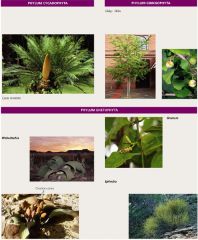
Gymnosperms include:
|

Gymnosperms include:
|
|
|
Pine Life Cycle
|
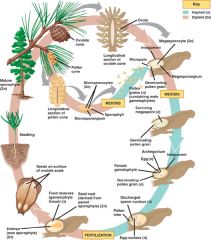
Pine Life Cycle
|
|
|
Concept 30.3:
|
The reproductive adaptations of angiosperms include flowers and fruits.
|
|
|
Also known as flowering plants or covered seeds; also the most widespread and diverse of all plants (250,00 species, 90% of all extant plant species).
|
Angiosperms
|
|
|
Angiosperms' derived traits are:
|
The reproductive structures called flowers and fruits.
|
|
|
Gymnosperms and angiosperms have the following traits in common except _________.
-seeds -pollen -vascular tissue -ovaries -ovules |
Ovaries
|
|
|
Flowers have ______ structure in angiosperms for sexual reproduction.
|
Specialized
|
|
|
Specialized shoot with modified leaves:
|
Sepals: enclose the flower
Petals: brightly colored, attract pollinators Stamen: produce pollen Carpel: produce ovules |
|
|
Typically consist of a mature ovary.
|
Fruits
|
|
|
Matures after fertilization of ovules in fruits, and can be carried by wind, water, or animals, enhancing dispersas.
|
Ovary
|
|
|
________ occurs when a pollen tube discharges two sperm into the female gametophyte within an ovule.
|
Double fertilization
|
|
|
First sperm in double fertilization:
|
Fertilizes the egg
|
|
|
Second sperm in double fertilization:
|
Combines with two nuclei in the center cell of the female gametophyte and initiates development of endosperm.
|
|
|
__________ nourishes the developing embryo.
|
Endosperm
|
|
|
Angiosperms originated at least _______ and diversified during the late Mesozoic.
|
140 MYA
|
|
|
__________ old fossils show some derived traits found in modern angiosperms.
|
125 MYA
|
|
|
"In and out of water hypothesis"
|
Common ancestors of angiosperms was aquatic plant, which reinvaded terrestrial habitats.
|
|
|
Pollen-producing and ovule-producing structures were separate on early flowering plants.
|
Evo-Devo hypothesis
|
|
|
________ in developmental genes brought them together in one structure - the flower.
|
Mutation
|
|
|
Flower is mostly _____.
|
Male
|
|
|
Concept 30.4:
|
Human welfare depends greatly on seed plants
|
|
|
No groups is more important to human survival as the ___________.
|
Seed plants
|
|
|
We depend on seeds for:
|
Food, wood, and many medicines.
|
|
|
With respect to angiosperms, which of the following is incorrectly paired with its chromosome count?
-Egg cell - n -Megaspore - 2n -Microsporocyte - 2n -Endosperm - 3n |
Megaspore - 2n
|
|
|
Pollen-producing and ovule-producing structures were separate on early flowering plants.
|
Evo-Devo hypothesis
|
|
|
________ in developmental genes brought them together in one structure - the flower.
|
Mutation
|
|
|
Flower is mostly _____.
|
Male
|
|
|
Concept 30.4:
|
Human welfare depends greatly on seed plants
|
|
|
No groups is more important to human survival as the ___________.
|
Seed plants
|
|
|
We depend on seeds for:
|
Food, wood, and many medicines.
|
|
|
With respect to angiosperms, which of the following is incorrectly paired with its chromosome count?
-Egg cell - n -Megaspore - 2n -Microsporocyte - 2n -Endosperm - 3n |
Megaspore - 2n
|
|
|
Flowers
|

Flowers
|
|
|
Fruits
|
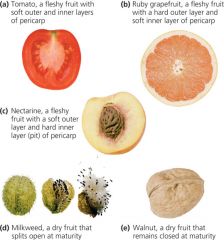
Fruits
|
|
|
Angiosperm Life Cycle
|
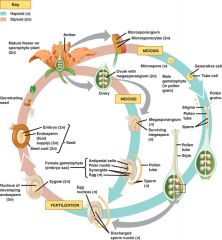
Angiosperm Life Cycle
|
|
|
Angiosperm Diversity
|
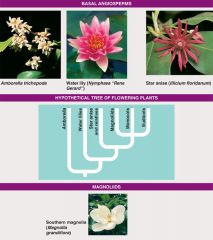
Angiosperm Diversity
|
|
|
Human welfare depends greatly on seed plants.
|

Human welfare depends greatly on seed plants.
|
|
|
Concept 31.1:
|
Fungi are heterotrophs that feed by absorption.
|
|
|
Fungi are ______, but do not ingest their food.
|
Heterotrophs
|
|
|
Fungi secrete ________ into their surrounding that break down complex molecules and absorb smaller organic molecules.
|
Exoenzymes
|
|
|
Fungi exhibit diverse lifestyles:
|
Decomposers known as saprotrophs
Parasite Mutualistic symbionts |
|
|
In seed bearing plants, microspores develop into __________.
|
Pollen grains
|
|
|
Which of the following is not a conifer?
-pine -fir -cedar -ginko |
Ginkgo
|
|
|
Three of the four answers below are seed producers. Select the exception.
-Ferns -Conifers -Dicots -Ginkos |
Ferns
|
|
|
The morphology of multicellular fungi enhances _______ of nutrients.
|
Absorption
|
|
|
Fungi consists of ______ , which are networks of branched hyphae.
|
Mycelia
|
|
|
Most fungi have cell walls made of _____.
|
Chitin
|
|
|
Some fungi have hyphae divided into cells by _______, with pore allowing cell-to-cell movement of materials.
|
Septa
|
|
|
________ fungi lack septa.
|
Coencocytic
|
|
|
Which of the following is a "job" not performed by any fungi?
-Decomposer -Parasite -Predator -Producer |
Producer
|
|
|
Some fungi have ______ that allow them to capture animals and/or penetrate the tissues of their hosts.
|
Hyphae
|
|
|
________ are mutualisms between fungi and plant host.
|
Mycorrhizae
|
|
|
Mycorrhizae that surrounds root cells.
|
Ectomcorrhizae
|
|
|
Mycorrhizae that extends hyphae through root-cell wall.
|
Endomycorrhizae
|
|
|
Concept 31.2:
|
Fungi produces spores through sexual or asexual life cycles
|
|
|
The sexual life cycle involves:
|
Cell fusion - plasmogamy
Nuclear fission - Karyogamy |
|
|
__________ is between plasmogamy and karyogamy.
|
Heterokaryotic stage
|
|
|
Cells have ________ nuclei from two parents.
|
Haploid
|
|
|
The diploid phase following ________ is short-lived and undergoes meiosis, producing haploid spores.
|
Karyogamy
|
|
|
Many fungi, such as molds, produce spores _________ on conidia.
|
Asexually
|
|
|
Single-celled ______ are produced by buds.
|
Yeasts
|
|
|
Molds and yeasts with no known sexual stage are classified as ________, or imperfect fungi.
|
Deuteromycetes
|
|
|
Concept 31.3:
|
Fungi descended from an aquatic, single-celled, flagellated protest.
|
|
|
Systamatists now recognize _________ and ________ as sister kingdoms.
|
Fungi and Animalia
|
|
|
Molecular evidence supports the hypothesis that:
|
Fungi and animals diverged from a common ancestor that was unicellular and bore flagella.
|
|
|
The oldest undisputed fossils of fungi are about ___________ old.
|
460 MY
|
|
|
_____ were among the earliest colonizers of land probably as symbionts with early land plants.
|
Fungi
|
|
|
Concept 31.4:
|
Fungi have radiated into a diverse set of Lineages.
|
|
|
Fungi classified in the phylum ______________.
|
Chytridiomycot
|
|
|
Chytrids are found in ___________ and ____________ habitats.
|
Freshwater; terrestrial
|
|
|
Chytrids can be:
|
Saprobic or parasitic
|
|
|
Chytrids are unique in having flagellated spores called __________.
|
Zoospores
|
|
|
Chytrids: once thought that all chytrids were ancestral group to other fungi.
Fungi lost flagella once. Molecular evidence suggests some chytrids were closely related to: |
Zygomycetes
|
|
|
Fungi, Zygomycetes, are found in the phylum ______________.
|
Zymgomycota
|
|
|
Zymgomycota includes:
|
Molds, parasites, and commensal symbionts
|
|
|
Zymgomycota are named for their sexaully produced:
|
Zygosporangia
|
|
|
Develop a rough, thick coat that can withstand harsh conditions for months.
|
Zygosporangia
|
|
|
When conditions improve, Zygosporangia undergo __________ then meiosis and produce ______________.
|
Karyogamy; Sporangium
|
|
|
Fungi, Glomeromycetes, are found in the phylum:
|
Glomeromycota
|
|
|
Glomeromycota were once considered __________, now classified in a separate phylum.
|
Czygomycetes
|
|
|
About 90% of all plants have mutualistic relationship with:
|
Glomeromycetes
|
|
|
Reproduce asexually by producing enormous numbers of spores called conidia.
|
Asomycetes
|
|
|
Phylum __________ also known as club fungi.
|
Basidiomycoa
|
|
|
Basidiomycetes includes:
|
mushrooms and shelf fungi
|
|
|
Basidiomycetes defined by clublike structure called a ___________.
|
Basidium
|
|
|
________ is usually long-lived and dikaryotice; can send up mushrooms in just a few hours.
|
Mycelium
|
|
|
Your parents are coming to visit and you immediately run to the pantry to throw away the loaf of bread with the black fuzzy stuff on it. What type of phylum of fungi did you just trash?
|
Zygomycota
|
|
|
Concept 31.5:
|
Fungi have a powerful impact on ecosystem.
|
|
|
Fungi are well-adapted ________ of organic material; breaks down dead material, recycles chemical elements between living an nonliving portion of ecosystems.
|
Decomposers
|
|
|
Form symbiotic relationships with plants and animals.
|
Fungi
|
|
|
Produces sugar - mycorrhizae.
|
Plant
|
|
|
Mutualism between fungi and plant hose increase ___________ and effects on growth of plants.
|
Productivity
|
|
|
Some fungi help animals break down plant materal. Some ants and termites raise fungi in "_______".
|
Farms
|
|
|
Symbiotic association between photosynthetic microorganisms and a fungus; very hardy organisms that can occupy harsh environments.
|
Lichens
|
|
|
Three growth forms of Lichens:
|
1. Fructose - branching
2. Foliose - leaf-like 3. Crustose - crust-like |
|
|
The fungal symbiont, Lichen, is most often an ___________.
|
Ascomycete
|
|
|
Single-celled green algae or _________ are the photosynthetic symbiont.
|
Cyanobacteria
|
|
|
Lichens have asexual reproduction by fragmentation or release of _________.
|
Soredi
|
|
|
Septate hyphae and coenocytic hyphae
|

Septate hyphae and coenocytic hyphae
|
|
|
Septate hyphae and coenocytic hyphae
|

Septate hyphae and coenocytic hyphae
|
|
|
Specialized hyphae - Mycorrhizae (Ectomycorrhiza and Endomycorrhizae)
|
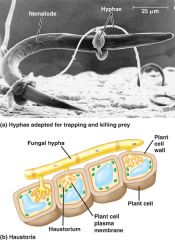
Specialized hyphae - Mycorrhizae (Ectomycorrhiza and Endomycorrhizae)
|
|
|
Generalized Fungi Life Cycle
|
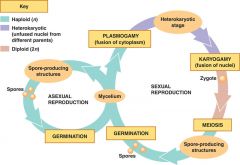
Generalized Fungi Life Cycle
|
|
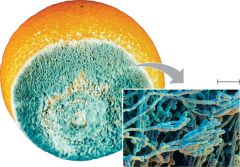
Asexual Reproduction
|

Asexual Reproduction
|
|
|
Chytrids
|
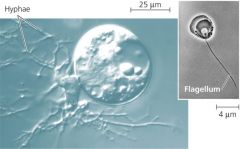
Chytrids
|
|
|
Chytrids - Zygomycetes
|
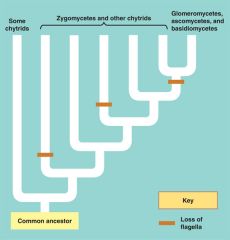
Chytrids - Zygomycetes
|
|
|
Life Cycle of Rhizopus Stolonifer
|
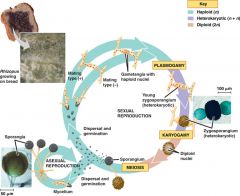
Life Cycle of Rhizopus Stolonifer
|
|
|
Ascomycete Life Cycle
|
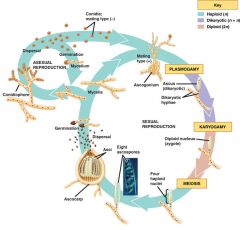
Ascomycete Life Cycle
|
|
|
Basidiomycete Life Cycle
|
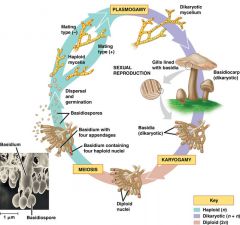
Basidiomycete Life Cycle
|
|
|
Mycorrhizae
|
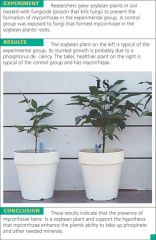
Mycorrhizae
|
|
|
Lichens Growth Forms:
1. Fructose - branching 2. Foliose - leaf-like 3. Crustose - crust-like |
Consult book for pictures
Figure 31.23 |
|
|
Lichens
|
Consult book for picture.
Figure 31.24 |
|
|
Which taxonomic group containing eukaryotic organisms is thought to be directly ancestral to the plant kingdom?
|
Green algae
|
|
|
Which process results in genetic recombination, but is separate from the process wherein the population size of paramecium increases?
|
Conjugation
|
|
|
Though plants, fungi, and prokaryotes all have cell walls, we classify them under different taxonomic units. Which of the observations below comes closest to explaining the basis for placing these organisms in different taxa?
|
Their cell walls are constructed from very different biochemicals.
|
|
|
Thread-like pseudopods that can perform phagocytosis are generally characteristic of which group?
|
cercozoans
|
|
|
In a practice known as crop rotation, farmers alternate a crop of legumes (plants whose roots bear nodules containing Rhizobium) with a crop of nonlegumes. What is the benefit of this practice?
|
Rhizobium fixes nitrogen, and the fixed nitrogen will fertilize the soil.
|
|
|
A mixotroph loses its plastids yet continues to survive. Which of the following most likely accounts for its continued survival?
|
It engulfs organic material by phagocytosis.
|
|
|
Which of the following statements is correct about gram-negative bacteria?
|
They often possess an outer membrane containing toxic lipopolysaccharides.
|
|
|
Modern mitochondria are the descendants of what were once free-living alpha proteobacteria. Insofar as mitochondria become inactive during periods of oxygen debt, what is probably true of their alpha proteobacterial ancestors?
|
They were obligate aerobes and heterotrophs.
|
|
|
You are given an unknown organism to identify. It is unicellular and heterotrophic. It is motile, using many short extensions of the cytoplasm, each featuring the 9+2 pattern. It has well-developed organelles and two nuclei, one large and one small. This organism is most likely to be a member of which group?
|
ciliates
|
|
|
A biologist discovers an alga that is marine, multicellular, and lives at a depth reached only by blue light. This alga probably belongs to which group?
|
red algae
|
|
|
Which group(s) within the Alveolata include(s) members that are important in ocean food webs, cause(s) red tides that kill many fish, and may even be carnivorous?
|
dinoflagellates
|
|
|
The typical prokaryotic flagellum features
|
a complex motor embedded in the cell wall and plasma membrane.
|
|
|
The following are all true about the life cycle of mosses except
|
gametes are directly produced by meiosis.
|
|
|
A biology student hiking in a northern forest happens upon an erect, 15-cm-tall plant that bears a pinecone-like structure at its tallest point. When disturbed, the cone emits a cloud of brownish dust. A pocket magnifying glass reveals the dust to be composed of tiny spheres with a high oil content.
This student has probably found a(n) |
club moss sporophyte.
|
|
|
Double fertilization means that angiosperms
|
have two sperm nuclei, both of which unite with nuclei of the female gametophyte.
|
|
|
A botanist discovers a new species of land plant with a dominant sporophyte, chlorophylls a and b, and a cell wall made of cellulose. In assigning this plant to a phylum, all of the following would provide useful information except whether or not the plant has
|
Spores
|
|
|
Which of the following is an ongoing trend in the evolution of land plants?
|
reduction of the gametophyte phase of the life cycle
|
|
|
Gymnosperms differ from both extinct and extant ferns because they
|
have pollen
|
|
|
Which of the following is true of seedless vascular plants?
|
Whole forests were once dominated by large, seedless vascular plants.
|
|
|
Which of the following is characteristic of alternation of generations in land plants?
|
Meiosis in sporophytes produces haploid spores.
|
|
|
The most recent common ancestor of all land plants was most similar to modern-day members of which group?
|
Charophycea
|
|
|
Which of the following statements is true of archegonia?
|
They may temporarily contain sporophyte embryos
|
|
|
Sporophylls can be found in which of the following?
|
pterophytes
|
|
|
In which of the following does the sporophyte depend on the gametophyte for nutrition?
|
Mosses
|
|
|
Which of these is most important in making the typical seed more resistant to adverse conditions than the typical spore?
|
integument(s)
|
|
|
All of the following are characteristic of angiosperms except
|
free-living gametophytes
|
|
|
The sugar-producing member of a mycorrhiza is a ____________.
|
Plant
|
|
|
Each basidium will produce how many spores?
|
Four
|
|
|
Concept 33.1:
|
Sponges are sessile and have porous body and choanocytes.
|
|
|
The Phylum ________ live in both fresh and marine waters, lack true tissues and organs, and have an asymmetrical body plan.
|
Porifera
|
|
|
These are suspension feeders.
|
Sponges
|
|
|
Sponges filter water through their ________.
|
Bodies
|
|
|
Doughnut-shaped cells that span body wall
|
Porocytes
|
|
|
Line spongocoel; movement of flagella that sets up water flow.
|
Choanocytes
|
|
|
Water movement through a sponge would follow what path?
|
Porocyte > spongocoel > osculum
|
|
|
Concept 33.2:
|
Cnidarians have radial symmetry, a gastrovascular activity, and cnidocytes
|
|
|
A wide range of sessile and floating forms including jellyfish, corals, and hydras
|
Cnidarians
|
|
|
Simple __________, radial plan - a body plan is a sac with a central gastrovascular cavity.
|
Diploblastic
|
|
|
Single opening serves as both a ________ and _______.
|
Mouth and anus
|
|
|
________ layer between epidermis and endodermis - gastrodermis.
|
Mesoglea
|
|
|
______ form is generally sessile.
|
Polyp
|
|
|
This Cnidarian form moves frely in water by passive drifting and contractions of the bell.
|
Medusa
|
|
|
Unique cells that function in defense and the capture of prey.
|
Cnidocytes
|
|
|
Stimulus causes Cnidarian cells to evert releasing the _______.
|
Thread
|
|
|
Most marine, a few freshwater; both polyp and medusa stages in most specis; polyp stage often colonial.
|
Hydrozoa (Cnidarian)
|
|
|
All marine; polyp stage reduced; free-swiminng; medusa up to 2 m in diameter.
|
Scyphozoa (Cnidarian)
|
|
|
All marine; box-shaped medusa; complex eyes.
|
Cubozoa
|
|
|
All marine; medusa stage completely absent; most sessile; many colonial.
|
Anthozoa
|
|
|
In the life cycle of a typical hydrozoan, which of the following would be most likely to be free-swimming?
|
Medusa
|
|
|
How many plans through the central axis will divide an organism with radial symmetry into roughly equal parts?
|
Many
|
|
|
Concept 33.3:
|
Most animals have a bilateral symmetry
|
|
|
Most animals belong to the _______ clade. Bilateral symmetry = cephalization.
|
Bilateral
|
|
|
Triploblastic development includes:
|
Ectoderm - outer layer
Mesoderm - middle layer Endoderm - inner layer |
|
|
Flatworms are also known as
|
Phylum Platyhelminthes
|
|
|
They live in marine, freshwater, and damp terrestrial habitats.
|
Flatworms
|
|
|
Flatworms are:
|
Triploblastic development, but acoelomate
|
|
|
Flatworm, most marine, some freshwater, a few terrestrial; predators and scavengers; body surface ciliated.
|
Turbellaria
|
|
|
Flatworm, marine and freshwater parasites; most infect external surfaces of fishes; life history simply; ciliated larva starts infection on host.
|
Monogenea (monogeaneans)
|
|
|
Flatworm, parasites, almost always vertebrates; two suckers attach to host; most life cycle include intermediate hosts.
|
Trematoda (trematodes, also called flukes)
|
|
|
Flatworm, Parasites of vertebrates; scolex attaches to host.
|
Cestoda (tape worm)
|
|
|
Most free living marine and freshwater worms, light-sensitive eyespots, centralized nerve net with anterior ganglia, and gastrovascular cavity with 2 way pharynx.
|
Class Turbellarians
|
|
|
Mature flukes live in the blood vessels of the human intestine, blood flukes reproduce sexually in the human host. Fertilized eggs exist in feces of host. Eggs develop in water into ciliated larvae. Larvae infect snails. Asexual reproduction within snail results in another type of motile larva. Larvae penetrate skin and blood vessels of humans.
|
Class Trematodes
|
|
|
Class cestoda, scolex attaches to host; Proglottids are the reprodutive structures; break off after fertilization.
|
Tapeworm
|
|
|
Phylum ______ are microscopic animals that inhabit aquatic habitats, smaller than protists; alimentary canal with separate mouth and anus; Pseudocoelomate; reproduce by parthenogenesis.
|
Rotifera
|
|
|
Which of the following combinations of phyla and characteristics is incorrect?
-Rotifera-parthenogenesis -Cnidaria-radial symmetry; polyp and medusa body form -Platyhelminthes-flatworms, gastrovascular cavity -Porifera-gastrovascular cavity, two tissue layers. |
Porifera
|
|
|
Concept 33.4:
|
Molluscs have a muscular foot, a visceral mass, and a mantle.
|
|
|
Removes metabolic wasts from hemolymph.
|
Nephridium
|
|
|
Most ________ have an open circulatory system; heart pumps hemolymph through arteries and into sinuses.
|
Mollusks
|
|
|
Rasp-like feeding organ, scrap and scoops of food items
|
Radula
|
|
|
Nerve ring around the esophagus and ventral nerve chord.
|
Nervous system
|
|
|
Also known as chitons; marine mollusks; shell has 8 plates; and food used for locomotion with radula and no true head.
|
Class Polyplacophora
|
|
|
Class _________ consists of snails and slugs; marine, freshwater, and terrestrial; assymmetrical body usually with a coiled shell and result of torsion rotation of the visceral mall. Foot for locomotion with radula.
|
Gastropoda
|
|
|
Class ________ consists of clams, mussules, scallops, oysters; live in marine and freshwater.
|
Bivalvia
|
|
|
Bivalvia's flattened shell with _______ valves; head reduced; paired gills; no radula and mostly suspension feeders.
|
Two
|
|
|
Class __________ consists of squids, cuttlefish, chambered nautili.
|
Cephalopoda
|
|
|
Cephalopoda live in ______ habitats. Head surrounded by grasping tentacles, usually with suckers.
|
Marine
|
|
|
Shell of cephalopoda may be:
|
external, internal, or absent
|
|
|
Concept 33.5:
|
Annelids are segmented worms. Annelids are also coelomate.
|
|
|
Anatomy of an Annelid (eg Earthwrom)'s body is divided into _______.
|
Segments. Each segment has a set of muscles that contract against coelomic fluid (hydrostatic skeleton).
|
|
|
Annelids have a ______ circulatory system with ______ pumping vessels (hearts).
|
Closed; five
|
|
|
___________ of Annelids are w/ specialized regions.
|
Alimentary canals
|
|
|
Concept 33.7:
|
Arthropods are segmented coelomates that have an exoskeleton and jointed appendages.
|
|
|
Two out every three known species of animals are _______.
|
Arthropods
|
|
|
General Characteristics of Arthropods:
|
1. Diversity and success is related to their segmented, exoskeleton, and jointed appendages.
2. Early arthropods showed little variation among segments. 3. Trend in arthropod evolution has been fusion of segments and specialization of appendages. 4. Arthropod body is covered by an exoskeleton made of chitin. When an arthropod grows it sheds the exoskeleton by a process called ECDYSIS. 5. Arthropods have an open circulatory system. Hemolymph is circulated into spaces surrounding tissues. 6. Variety of gas exchange organs are gills, tracheal tubes, and book lungs. |
|
|
________ include spiders, scorpions, ticks, and mites.
|
Arachnid Anatomy
|
|
|
Body of Arachnid has 2 regions:
|
Cephalothorax and Abdomen
|
|
|
Cephalothorex has __ pairs of appendages which are:
|
6; pedipalps, chelicerae, and 4 pairs of walking legs.
|
|
|
Book lungs are used for ________.
|
Respiration
|
|
|
Subphylum __________ consist of millipedes and centipedes.
|
Myriapoda
|
|
|
Class __________ has two pairs of legs per segment, and ditritus feeders in leaf litter.
|
Diplopoda - millipedes
|
|
|
Class _______ has one pair of legs per segment and are carnivores.
|
Chilopoda - centipedes
|
|
|
Subphylum ________ consists of insects and their relatives; more species rich than all other life forms.
|
Hexapoda
|
|
|
_____ are characterized by having 3 pairs of walking legs on the thorax, 1 or 2 pairs of wings, and 3 body regions.
|
Insects
|
|
|
Subphylum ________ are mostly marine and freshwater, biramous appendages, and gills for gas exchange.
|
Custacea
|
|
|
Three of the four animals listed below possess some type of coelom, select the exception:
-annelids -arthropods -molluscs -platyhelminths |
Platyhelminths
|
|
|
Concept 33.8:
|
Echinoderms and chordates are deuterostomes
|
|
|
_________ may not look like chordates, which includes the vertebrates, but they share a common development plan.
|
Echinoderms
|
|
|
________ has radial cleavage, coelom develops from archenteron, and mouth forms oppostie of blastospore.
|
Deuterostomes
|
|
|
Phylum _________ includes echinoderm - spiny skin, slow moving or sessile marine animals, pentaradial symmetry, and unique water-vascular system.
|
Echinodermata
|
|
|
Mr. Crabs from spongebob is a member of what subphylum?
|
Crustacea
|
|
|
Squidward Tentacles belongs to what class?
|
Cephalopoda
|
|
|
Which of the following characteristics is not true of all animal phyla?
-multicellular -organ systems -heterotrophic -diploid |
Organ systems
|
|
|
Cnidarians do not have _____.
-tentacles equipped with nematocysts. -three tissue layers -radial symmetry -a gastrovascular cavity. |
Three tissue layers
|
|
|
Oval body, eight dorsal plates, grazer on rocky coasts is descriptive of _______.
|
Polyplacophora
|
|
|
The difference between pseudocoelomates and coelomates is that pseudocoelomates _____, whereas coelomates _____.
|
have a body cavity partially lined with tissue derived from mesoderm ... have a body cavity completely lined with tissue derived from mesoderm
|
|
|
Mushrooms with gills, typically available in supermarkets, have meiotically produced spores located in or on ________ and belong to the phylum ________.
|
basidia; Basidiomycota
|
|
|
Consider the following list of animals: giant squid, earthworm, largemouth bass, snail, tapeworm, coral, and starfish. The two that belong to the same phylum are the _____, and their phylum is _____.
|
giant squid and snail ... Mollusca
|
|
|
The functional significance of porous septa in certain fungal hyphae is most similar to that represented by the ________ of certain animal cells, and by the ________ of certain plant cells.
|
gap junctions; plasmodesmata
|
|
|
Which characteristic is not true of sponges?
|
All of the above are characteristics of sponges.
|
|
|
A biologist is trying to classify a new organism on the basis of the following characteristics: fungus-like in appearance, reproduces by conidia, has no apparent sexual phase, and parasitizes woody plants. If asked for advice, to which group would you assign this new species?
|
Deuteromycota
|
|
|
Which one of the following is not a feature of polychaete worms (phylum Annelida, class Polychaeta) ?
|
a water vascular system
|
|
|
An active marine predator is found possessing these characteristics: a series of tentacles (modified from the foot) , a highly developed nervous system, and elaborate eyes. To which of the following animal classes does this organism most likely belong?
|
Cephalopoda
|
|
|
What are the sporangia of bread molds?
|
asexual structures that produce haploid spores
|
|
|
In fungi, karyogamy does not immediately follow plasmogamy, which
|
results in heterokaryotic cells.
|
|
|
You are given an organism to identify. It has a fruiting body that contains many structures with eight haploid spores lined up in a row. What kind of a fungus is this?
|
ascomycete
|
|
|
The choanocyte of a sponge and the nematocyst of a cnidarian both function in _____.
|
obtaining food
|
|
|
Jellies and corals are members of the same _____, all members of which _____.
|
phylum ... have special stinging cells on their tentacles
|
|
|
What is the primary role of a mushroom's underground mycelium?
|
absorbing nutrients
|
|
|
Tapeworms are highly specialized worms that make their living as endoparasites. To which of the following phyla and classes do the tapeworms belong?
|
phylum Platyhelminthes, class Cestoidea
|
|
|
Lichens are symbiotic associations of fungi and
|
either cyanobacteria or green algae.
|
|
|
Symmetry is one of the most basic characteristics of animals. The group that has a different symmetry from the other four groups listed here is the _____.
|
jellies
|
|
|
An unidentified species of animal displays the following characteristics: bilateral symmetry, protostome development, a complete digestive system, an open circulatory system, and distinct body segmentation. To which one of the following animal phyla does this species most likely belong?
|
Arthropoda
|
|
|
Which of the following is not a characteristic of hyphate fungi (fungi featuring hyphae)?
|
Their cell walls consist mainly of cellulose microfibrils.
|
|
|
Sponges
|
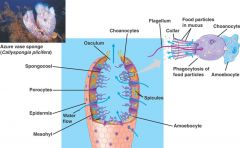
Sponges
|
|
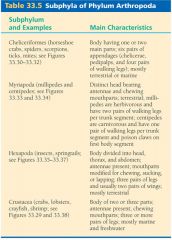
Cnidarian Body Plans
|

Cnidarian Body Plans
|
|
|
Cnidarians
|
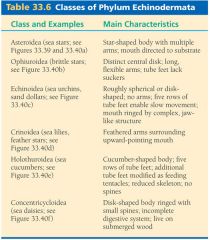
Cnidarians
|
|
|
Consult Book 33.7
|
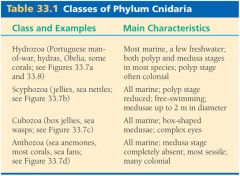
Cnidarian Diversity
|
|
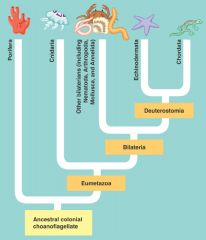
Triploblastic Development
|

Triploblastic Development
|
|
|
Triploblastic Development
|

Triploblastic Development
|
|
|
Flatworm Diversity
|
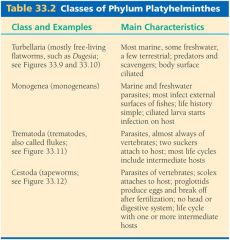
Flatworm Diversity
|
|
|
Class Turbellarians
|
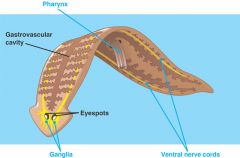
Class Turbellarians
|
|
|
Class Trematodes
|
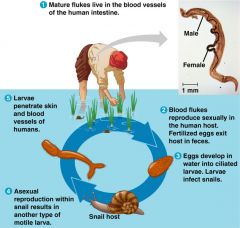
Blood Fluke Cycle
|
|
|
Tapeworms
|

Tapeworms
|
|
|
Rotifers
|
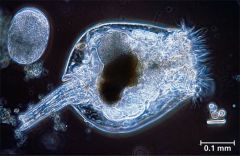
Rotifers
|
|
|
Basic Mollusc Body Plan
|
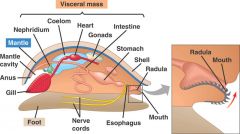
Basic Mollusc Body Plan
|
|
|
Class Polyplacophora
|
Consult book.
|
|
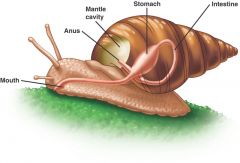
Class Gastropoda
|

Class Gastropoda
|
|
|
Class Bivalvia
|
Consult book. 33.20 & 33.21
|
|
|
Annelid Diversity
|
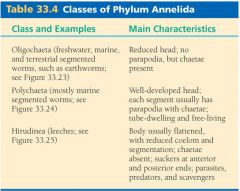
Annelid Diversity
|
|
|
Arthropods
|
Consult book. 33.28 & 33.39
|
|

Four Major Lineages of Arthropods
|
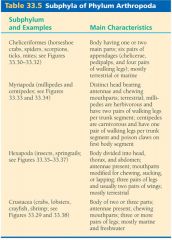
Four Major Lineages of Arthropods
|
|
|
Arachnid Anatomy
|
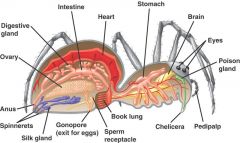
Arachnid Anatomy
|
|
|
Insect Anatomy
|
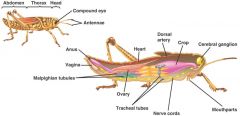
Insect Anatomy
|
|
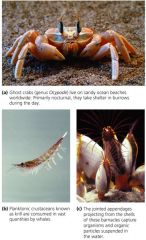
Subphylum Crustacea
|

Subphylum Crustacea
|
|
|
Phylum Echinodermata
|

Phylum Echinodermata
|
|
|
Echinoderm Diversity
|
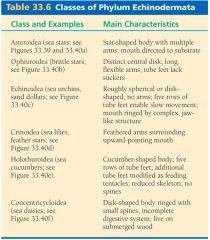
Echinoderm Diversity
|

